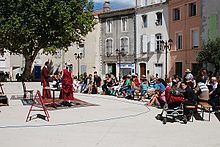Ganges (Hérault)
| Ganges | ||
|---|---|---|

|
|
|
| region | Occitania | |
| Department | Herault | |
| Arrondissement | Lodève | |
| Canton | Lodève | |
| Community association | Cévennes Gangeoises et Suménoises | |
| Coordinates | 43 ° 56 ' N , 3 ° 42' E | |
| height | 138-540 m | |
| surface | 7.16 km 2 | |
| Residents | 4,024 (January 1, 2017) | |
| Population density | 562 inhabitants / km 2 | |
| Post Code | 34190 | |
| INSEE code | 34111 | |
| Website | http://ganges.fr/ | |
 Bird's eye view of the Ganges |
||
Ganges is in Hérault in the region Okzitanien located city in southern France . It has 4024 inhabitants (as of January 1, 2017), who are called Gangeois . The partner municipality of Ganges is Schwalmtal on the Lower Rhine.
geography
Ganges is located on the southern edge of the Cevennes (and thus the Massif Central ) at the confluence of the Hérault , Vis and Rieutord . The Gard department borders to the north, west and east . The area around Ganges is karst mountains with many gorges and caves. The highest peaks in the area ("local mountains") are Roc Blanc (911 m) and Pic d'Anjeau (864 m).
history
A settlement in the area of today's city is first documented for the 12th century. Finds of Gallo-Roman graves and Roman coins prove, however, that the place had been inhabited for much longer. In 1270 the “Commune” Ganges was granted the right to elect two city leaders (“Syndics”) and a twelve-person council. Ganges is at the center of the Huguenot Wars (Guerre des Camisards ). They are a consequence of the Edict of Fontainebleau , with which Louis XIV ended a period of relative religious freedom in 1685. The Protestant uprising began in the region around Ganges in 1702 and culminated on March 4, 1703 with the occupation of the city by several hundred armed " Camisards ". They kill nine of the king's soldiers and occupy the city for three months. By 1710 the uprising was completely suppressed.
The castle of Ganges is first mentioned at the beginning of the 11th century. On June 5, 1667, Diane de Joannis de Chateaublanc , the Marquise de Ganges, dies after an attempted murder by her two brothers-in-law. The castle in the heart of the city has been falling into disrepair since the end of the 19th century, it was bought by the city in 1905 and demolished the following year. In its place the market hall will be built, which is still used twice a week for a food market.
Population development
| 1962 | 1968 | 1975 | 1982 | 1990 | 1999 | 2006 | 2017 |
|---|---|---|---|---|---|---|---|
| 4926 | 4872 | 3858 | 3533 | 3343 | 3503 | 3887 | 4024 |
economy
Up until the modern era, the Ganges economy was geared towards self-sufficiency. Only the salt trade on the long-distance routes between the Mediterranean and the Cevennes brings some money from outside into the city. That changed fundamentally in the middle of the 18th century with the start of silk production - the golden age of the city dawned.
In 1810, 2,000 of the 4,500 inhabitants of Ganges are employed in the production of silk and silk stockings. Half a century later, however, the decline of silkworm breeding begins . In 1860, 20,000 kg of silk were still being produced in Ganges. Diseases of the silkworms, competition from Italy and Asia as well as the invention of artificial silk herald the end of silk production. The production of yarn and textiles, especially stockings , will remain the determining economic factor for a long time to come. In 1914, eight percent of French silk yarn production comes from Ganges. In 1938 more than 500,000 pairs of silk stockings were made here. In 1942, 3,813 people were employed in 24 factories to produce almost a fifth of French silk stockings. In the 1970s, however, stocking production gradually came to a standstill.
In the immediate vicinity of Ganges (St. Laurent-le-Minier) there was also mining for copper, iron, lead, silver and zinc from the Middle Ages until 1992. Since then there has hardly been any manufacturing industry. Tourism has become the most important economic factor. Hiking, climbing, canoeing, cave excursions and hang gliding are some of the activities that attract visitors and generate revenue for many small businesses.
Town twinning
Ganges has a partnership with the German municipality of Schwalmtal in North Rhine-Westphalia.
Personalities
- Diane de Joannis de Chateaublanc , Marquise de Ganges (1635–1667), was murdered in Ganges
- Antoine Fabre d'Olivet (1768–1825), writer, historian and philologist
- Jules Émile Planchon (1823–1888), botanist and pharmacy professor
literature
- Julien Rouquette: Histoire de la Ville de Ganges. Nîmes 1995
- Raymond Dugrand and Pascal Coularou: Il était une fois Ganges. Le Plein des Sens publishing house, 2000



